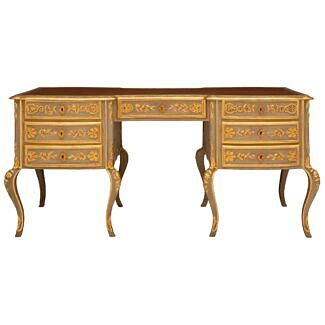A Continental 19th century Biedermeier Empire/Neo-Classical st. Burl Walnut, Ebonized Fruitwood, Giltwood and Ormolu Bureau Plat by Francois Linke
List: $89,800.00
A sensational and extremely high quality Continental 19th century Biedermeier Empire/Neo-Classical st. Burl Walnut, Ebonized Fruitwood, Giltwood and Ormolu Bureau Plat by Francois Linke. This important and unique desk is raised on eight ball supports covered by scale like Ormolu... — Read More
A sensational and extremely high quality Continental 19th century Biedermeier Empire/Neo-Classical st. Burl Walnut, Ebonized Fruitwood, Giltwood and Ormolu Bureau Plat by Francois Linke. This important and unique desk is raised on eight ball supports covered by scale like Ormolu decorations. Above each ball is a architectural column with an Ormolu plinth and top capital with palmette designs. The columns flank the three drawers of each side support of the desk, of which one of the drawers is fitted with a locked safe. The top frieze of the desk has three drawers with the central one with a scrolled pierced Ormolu keyhole escutcheon and Giltwood band. The two outer drawers each display a central inlaid plaque of a seated woman holding a laurel branch surrounded by an Ormolu frame and scrolled decorative mounts. The top is fitted with its brown gold tooled leather and is surrounded by a handsome Ormolu gallery.
François Linke (1855-1946) Renowned 19th Century Parisian Ébéniste. Linke created historical interpretations of Louis XV and Louis XVI styles. He displayed at the Paris Universal Exhibition of 1900 where he received a gold medal. — Read Less
- Item # 13808
-
H: 29.25 in L: 62.25 in D: 33.25 in
H: 74 cm L: 158 cm D: 84 cm
- Continental
- 19th Century
- Ebonized Fruitwood, Giltwood, Ormolu, Walnut
- Biedermeier st. Read More, Empire st. Read More, Neo-Classical st. Read More
- François Linke Read More
Related products
-
# 13499 - H: 31" L: 68" D: 35"
-
# 11376 - H: 32" L: 55" D: 30"
-
# 5585 - H: 30" L: 64" D: 30"
-
# 9595 - H: 31" L: 69" D: 31"











































